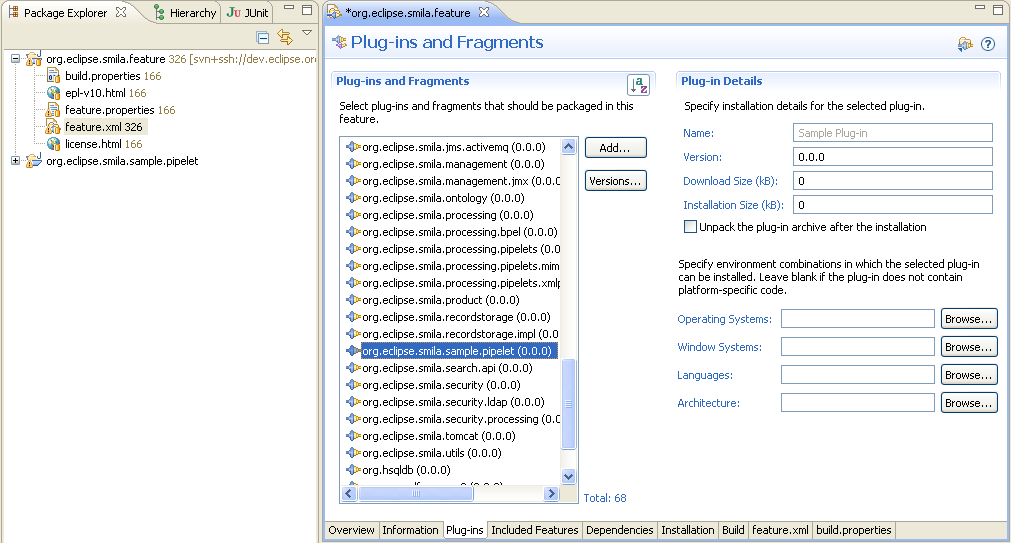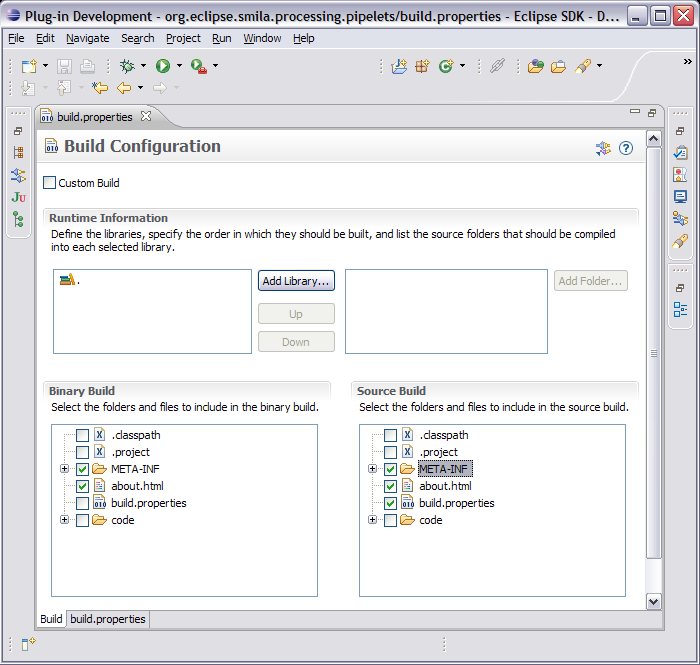Notice: this Wiki will be going read only early in 2024 and edits will no longer be possible. Please see: https://gitlab.eclipse.org/eclipsefdn/helpdesk/-/wikis/Wiki-shutdown-plan for the plan.
Difference between revisions of "SMILA/Documentation/HowTo/How to integrate new bundle into build process"
| Line 19: | Line 19: | ||
</td></tr> | </td></tr> | ||
</table> | </table> | ||
| + | |||
| + | === '''2. Optionally: Generate Source Bundle ''' === | ||
| + | |||
| + | The build process can also generate an additional source bundle for a new bundle so that debugging is easier when SMILA is used as a target platform (see [[SMILA/Development Guidelines/How to set up integration environment|How to set up the integration environment]]). This needs some manual modification of the files of the feature that includes the bundle: | ||
| + | |||
| + | * In <tt>org.eclipse.smila.feature/build.properties</tt> add a line like this using the bundle name of your new bundle: | ||
| + | |||
| + | <source lang="text"> | ||
| + | generate.plugin@org.eclipse.smila.sample.pipelet.source = org.eclipse.smila.sample.pipelet | ||
| + | </source> | ||
| + | |||
| + | * In <tt>org.eclipse.smila.feature/feature.xml</tt> add an entry like this to include the source bundle in the feature: | ||
| + | |||
| + | <source lang="xml"> | ||
| + | <plugin | ||
| + | id="org.eclipse.smila.sample.pipelet.source" | ||
| + | download-size="0" | ||
| + | install-size="0" | ||
| + | version="0.0.0" | ||
| + | unpack="false"/> | ||
| + | </source> | ||
| + | |||
| + | : Ignore the warning that the bundle cannot be resolved. It is generated automatically at build time. | ||
| + | |||
| + | * In your bundle be sure to add at least the META-INF directory, the about files and the build.properties to the build configuration of the source build. Add additional files (schemas, sample configs, etc) as appropriate. Do NOT add the <tt>code/src</tt> or other source directories, this is done automatically by the build process: | ||
| + | |||
| + | [[Image:SMILA-bundle-source-build-properties.png]] | ||
Revision as of 06:13, 29 April 2009
The following steps have to be done to integrate a new bundle (plug-in) in the SMILA build process:
1. Include new plug-in into org.eclipse.smila.feature
For further information see: Howto build a SMILA Distribution
|
Useful Information From today (build process depends on make.xml) you don´t have to modify the build file (make.xml) anymore. The make.xml file includes all bundles,those are located under the local trunk folder. If you don´t want to include your new bundle into the build process, the bundle has to excluded explicit in the make.xml. For further information see: Introduction to make.xml. |
2. Optionally: Generate Source Bundle
The build process can also generate an additional source bundle for a new bundle so that debugging is easier when SMILA is used as a target platform (see How to set up the integration environment). This needs some manual modification of the files of the feature that includes the bundle:
- In org.eclipse.smila.feature/build.properties add a line like this using the bundle name of your new bundle:
generate.plugin@org.eclipse.smila.sample.pipelet.source = org.eclipse.smila.sample.pipelet
- In org.eclipse.smila.feature/feature.xml add an entry like this to include the source bundle in the feature:
<plugin id="org.eclipse.smila.sample.pipelet.source" download-size="0" install-size="0" version="0.0.0" unpack="false"/>
- Ignore the warning that the bundle cannot be resolved. It is generated automatically at build time.
- In your bundle be sure to add at least the META-INF directory, the about files and the build.properties to the build configuration of the source build. Add additional files (schemas, sample configs, etc) as appropriate. Do NOT add the code/src or other source directories, this is done automatically by the build process:


